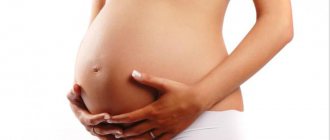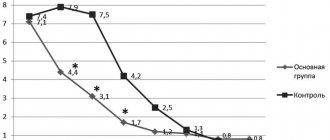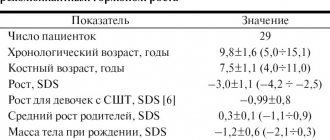Priorix is an imported vaccine against measles, rubella and mumps. Manufacturer: GlaxoSmithKline Biologicals sa, Belgium. The vaccine is proven to be highly effective: antibodies against measles are detected in 98% of those vaccinated, against rubella in 99% and against mumps in 96%. Priorix fully complies with WHO requirements for the production of biological products.
Why vaccinate your child against measles?
Measles is one of the most dangerous “childhood” diseases. Firstly, it is extremely contagious: the chances of getting sick after contact with someone with measles are close to 100%. A decrease in the percentage of vaccinated children, even by a small amount, immediately results in a surge in the incidence of measles. Already in the 2000s, epidemics were recorded in such prosperous countries as Ireland and the USA: the reasons were the availability of air travel and refusals to vaccinate. Secondly, measles has a high mortality rate (although not as high as tetanus and diphtheria), and children under 5 years of age are especially susceptible to it. Measles still has no specific treatment – only symptomatic treatment. In addition, it causes severe complications on the respiratory system, including bronchitis and pneumonia, and can also lead to partial loss of hearing or vision in the child.
The effectiveness of the Priorix vaccine
When a vaccine is administered, the human body produces antibodies in response to foreign agents. Numerous clinical trials were conducted with the Priorix vaccine on a large statistical sample, which showed the high effectiveness of the drug. After vaccination, protective bodies against measles were found in 98% of those vaccinated, against mumps - in 96%, and against rubella - in 99%. A repeated test for antibodies to viruses a year later revealed active antibodies against measles and rubella in the same number of vaccinated people, and against mumps in 88% of those examined.
The Priorix vaccine has been approved by international organizations (such as WHO) and meets all safety and effectiveness requirements.
Why vaccinate your child against rubella?
It is known that rubella is most dangerous for pregnant women, since it has an extremely negative effect on the fetus: more than half of newborns experience deafness, and blindness and heart disease are also common. Therefore, the advisability of rubella vaccination for women planning pregnancy seems to be beyond doubt. However, parents often ask the question: why vaccinate a one-year-old girl or, especially, a boy against rubella? After all, it is known that in most cases rubella is quite mild?
As in the case of mumps, the most well-known complication among the people is far from the only one and, alas, not even the most terrible. Progressive rubella panencephalitis, a rare but terrible complication, most often affects boys aged 8 to 19 years. With this complication, a person’s intellect gradually fades and motor functions die off, and it ends with dementia and death. Other complications from rubella that do not discriminate by gender include arthritis, pneumonia and hepatitis.
Vaccination scheme
In Russia, vaccination is usually carried out in accordance with the National Calendar of Preventive Vaccinations. If the vaccination schedule is violated, it is possible to discuss an individual vaccination plan with your doctor.
Primary vaccination against measles, rubella, mumps is recommended at the age of 12 months and consists of a single dose of the vaccine. Subsequent revaccination is performed at the age of 6 years and also involves a single injection of the vaccine preparation. Using the drug Priorix is very convenient - the vaccination schedule is easy to understand and remember for parents, and is also the least traumatic for the child, due to fewer injections.
Girls of puberty are additionally vaccinated against rubella at 13 years of age. You can also get vaccinated if they have not been vaccinated before or have been vaccinated once with any of the vaccine preparations.
Clinical studies have shown the effectiveness of the Priorix vaccine. A significant advantage of the Priorix vaccine is its compatibility with other vaccines except BCG. This means that other vaccinations can be given on the same day, but in different areas of the body. It has been proven that combined use does not affect the effectiveness of immunization and tolerability.
Why vaccinate your child against mumps?
Mumps (mumps) is not a deadly disease, but can lead to extremely unfavorable complications. It gained fame due to the fact that it is a fairly common cause of infertility in men, which develops as a result of orchitis - inflammation of the testicles. The fact is that the mumps virus affects glandular tissue and is not limited to the postauricular salivary glands (although they are, indeed, usually affected first), but can develop in the tissues of the thyroid gland, pancreas, testicles in boys or ovaries in girls.
Two of the most common myths about the vaccine against it are associated with this feature of mumps. First: the vaccine causes infertility in boys. Of course, this is not true. When grafting, testicular tissue is not affected. Second: there is no point in vaccinating boys before puberty. And this is not so - infertility is caused not by low-quality sperm, but by atrophy of testicular tissue, which, unfortunately, does not depend on age. And high-quality immunity is formed after revaccination, and you may simply not have time to vaccinate your child before he gets sick.
The second question, no less frequent: if mumps is dangerous only for boys, why vaccinate girls? Just for the sake of the notorious population immunity? Of course not. The fact is that, in addition to orchitis, partotitis can cause pancreatitis, and this is lifelong, because the pancreas tissue is not restored; as well as encephalitis and meningoencephalitis - the most dangerous types of brain inflammation. Not very often, but it still happens that the experience of mumps ends in deafness.
Description of the drug
The Priorix vaccine is a combination attenuated vaccine designed to prevent measles, rubella and mumps.
The Priorix vaccine contains attenuated (weakened) vaccine strains of the measles virus (Schwarz), mumps (RIT 4385, derivative of Jeryl Lynn) and rubella (Wistar RA 27/3), which are cultivated separately in chicken embryo cell culture (measles and mumps viruses) and human diploid cells (rubella virus), which allows you to simultaneously (with one injection) immunize a child against three infectious diseases: measles, rubella and mumps.
Measles is a highly contagious viral infection transmitted by airborne droplets. The measles virus mainly affects the upper respiratory tract and lungs, which is manifested by acute laryngitis with necrosis of the laryngeal mucosa, prolonged bronchitis and severe pneumonia. For 6-12 months after the illness, the body is in a state of severe immunodeficiency, which is manifested by frequent and severe respiratory diseases.
Rubella is a highly contagious viral infection transmitted by airborne droplets. Rubella can be congenital or acquired.
Acquired rubella is manifested by a widespread small-spotted rash, swollen lymph nodes and severe intoxication.
Congenital rubella is a chronic intrauterine infection of the fetus. The virus is transmitted from mother to child through the placental barrier, leading to fetal death, early miscarriage or severe developmental defects and deformities, such as deafness, cataracts, various heart and brain defects, often incompatible with life.
Mumps is a highly contagious viral infection transmitted by airborne droplets. Mumps is manifested by severe intoxication, damage to the salivary glands, the central nervous system (including meningitis), pancreatitis, orchitis (inflammation of the testicles, often leading to infertility).
Possible side effects of Priorix
The specificity of the vaccine against measles, rubella and mumps is that it gives two waves of reaction: the first - within 24 hours after vaccination and the second - approximately 9-10 days after it. The child's condition should be carefully monitored during these periods of time.
In 60% of cases, Priorix vaccination is tolerated by the child without any consequences.
In the remaining cases, the most common occurrence is a rise in temperature, which accompanies the body's production of protective antibodies. Runny nose, cough, hives, pain and swelling at the injection site are also common.
Less common consequences of vaccination are upper respiratory tract infections, otitis media, bronchitis, nervousness, insomnia, conjunctivitis, febrile convulsions.
If any symptoms last longer than two days, you should consult a doctor.
special instructions
It is possible to use the vaccine during breastfeeding after assessing the expected benefits and potential risks.
Vaccination of women of childbearing age is carried out in the absence of pregnancy and only if the woman agrees to be protected from conception for 3 months after vaccination.
Caution should be exercised when administering the vaccine to individuals with a personal or family history of allergies and seizures. It should be taken into account that after administration of the vaccine, due to the possible risk of developing immediate allergic reactions, the patient should be under medical supervision for 30 minutes. Vaccination sites must be provided with anti-shock therapy, incl. solution of epinephrine (adrenaline) 1:1000.
Before administering the vaccine, you should make sure that the alcohol or other disinfectant has evaporated from the surface of the skin and the vial stopper, because these substances can inactivate attenuated viruses in the vaccine.
How to prepare for the Priorix vaccination
To properly prepare for vaccination, you should protect your child from possible consequences. Firstly, for several days before and after vaccination you should not visit crowded places or contact people who are known to be sick (if you have to, reschedule the vaccination). Secondly, carefully monitor possible manifestations of ARVI in the child: he must be completely healthy. You should also not vaccinate if your child is actively teething.
It is necessary to eat light, healthy foods, do not overindulge in sweets and allergens, and drink more clean water. You should not introduce new complementary foods on the day of vaccination.
The child’s room, or better yet the entire apartment, should be well ventilated. The indoor humidity level should be maintained at least 65%.
You can give your child an antihistamine, such as Zyrtec, for several days before and after the vaccination.
Contraindications
- primary and secondary immunodeficiencies (however, the drug can be used in persons with asymptomatic HIV infection, as well as in patients with AIDS);
- acute diseases and exacerbations of chronic diseases (for mild ARVI, acute intestinal diseases, vaccination is allowed immediately after the temperature normalizes);
- pregnancy;
- allergic reactions to previous administration of the drug;
- hypersensitivity to neomycin, any other vaccine ingredient and chicken eggs (however, a history of contact dermatitis caused by neomycin and an allergic reaction to non-anaphylactic chicken eggs is not a contraindication to vaccination).
Vaccination at MC "SANMEDEXPERT"
It is better to prevent any disease than to treat it. It is much simpler, safer for health and more financially profitable. If you want to protect yourself and your loved ones through vaccination, contact us. Our center has been providing impeccable medical services for 10 years. All specialists have more than 5 years of experience and regularly improve their skills. Doctors closely monitor the well-being of patients after vaccination and are especially attentive to children.
You can find out if Priorix is in stock by calling: +7 (499) 678-03-03. You can also order a call back on the website.
Features of the procedure and preparation for it
Once you make an appointment with us, you will need to be examined by a doctor before the procedure. Tell us if you have had any recent illnesses, if there are any allergic reactions or chronic pathologies. For young patients, the doctor prescribes preliminary tests to completely eliminate negative consequences. It is also recommended to take antihistamines 3-4 days before. Before vaccination, it is advisable not to be in public places to avoid contracting infectious diseases.
The drug is injected into the muscle. Children under 3 years old can have Priorix placed in the thigh area. At an older age, the injection is given in the shoulder.
Priorix
| Vaccine against measles, mumps, rubella live culture , Belgium |
Composition and release form Lyophilisate for the preparation of a solution for intramuscular and subcutaneous administration in the form of a homogeneous porous mass from white to slightly pink; the attached solvent is a clear, colorless, odorless liquid, free of visible impurities.
| Component | 1 dose |
| Attenuated vaccine strain of measles virus (Schwarz) | not less than 3.5 lgTCD50 |
| Attenuated mumps virus vaccine strain (RIT4385, Jeryl Lynn derivative) | not less than 4.3 lgTCD50 |
| Attenuated vaccine strain of rubella virus (Wistar RA 27/3) | not less than 3.5 lgTCD50 |
Other ingredients: neomycin sulfate (not more than 25 mcg), lactose, sorbitol, mannitol, amino acids. Solvent: water for injection - 0.5 ml. 1 dose - bottles (1) complete with solvent (amp.) - contour cell packaging (1) - cardboard boxes. 1 dose - bottles (100) - cardboard boxes complete with solvent (amp. 100 pcs.) in a separate box. 1 dose - bottles (1) complete with solvent (syringes), d/i needles (1 or 2 pcs.) - contour cell packaging (1) - cardboard boxes.
Solvent: water for injection - 5 ml. 10 doses - dark glass bottles (50) - cardboard boxes complete with solvent (amp. 50 pcs.) in a separate box.
Registration number Lyophilisate for preparation. solution for intramuscular and subcutaneous administration 1 dose: vial. included with solvent 0.5 ml; lyophilisate for preparation. solution for intramuscular and subcutaneous administration 1 dose: vial. included with 0.5 ml solvent, d/i needles; lyophilisate for preparation. solution for intramuscular and subcutaneous administration 10 doses: vial. — P No. 015888/01 10.08.04
Pharmacological action Live combined attenuated vaccine against measles, mumps and rubella. Attenuated vaccine strains of measles virus (Schwarz), mumps virus (RIT 4385, derivative of Jeryl Lynn) and rubella virus (Wistar RA 27/3) are cultivated separately in chicken embryo cell culture (measles and mumps viruses) and human diploid cells (rubella virus). Antibodies to the measles virus were detected in 98% of those vaccinated, to the mumps virus in 96.1% and to the rubella virus in 99.3%. One year after vaccination, all seropositive individuals retained a protective titer of antibodies to measles and rubella and 88.4% to the mumps virus. Priorix meets WHO requirements for the production of biological products, requirements for vaccines against measles, mumps, rubella and live combination vaccines.
Indications Prevention of measles, mumps and rubella from the age of 12 months.
Dosage regimen The vaccine is administered subcutaneously or intramuscularly in a dose of 0.5 ml. Intravenous administration of the vaccine is not allowed! In accordance with the national vaccination schedule, Priorix is administered to children at the age of 12 months, followed by vaccination at the age of 6 years. In addition, revaccination is indicated for girls aged 13 years who have not been vaccinated against measles, rubella and mumps or who have received less than 2 doses of these vaccines.
Rules for preparing the solution Immediately before use, add the contents of the supplied syringe or ampoule with solvent into the bottle with the drug at the rate of 0.5 ml per 1 dose. Shake the bottle thoroughly until completely dissolved. The dissolution time of the drug should not exceed 1 minute. The dissolved drug is a clear liquid from light orange to light red. If the solution looks different or there are foreign particles, the vaccine is not used. A new sterile needle must be used to administer the drug. When using a vaccine in a multi-dose package, a new syringe and needle must be used to withdraw the drug each time. The dissolved drug in multi-dose packaging should be used during the working day (within no more than 8 hours) provided it is stored in the refrigerator (at a temperature of 2° to 8°C). The drug must be removed from the bottle in strict compliance with the rules of asepsis. Side effects Possible: most often - rash, fever, hyperemia, pain and swelling at the injection site; rarely - swelling of the parotid salivary glands, febrile convulsions. In some cases: development of symptoms characteristic of upper respiratory tract infection (rhinitis, cough, bronchitis); diarrhea, vomiting, anorexia, drowsiness, increased excitability, insomnia, acute otitis media, lymphadenopathy. Contraindications – primary and secondary immunodeficiency (however, the drug can be used in persons with asymptomatic HIV infection, as well as in patients with AIDS) with a CD4+ lymphocyte level >=25% of the age norm; – acute diseases and exacerbations of chronic diseases (for mild ARVI, acute intestinal diseases, vaccination is allowed immediately after the temperature has returned to normal); – pregnancy (vaccination is carried out no later than 3 months before conception); – allergic reactions to previous administration of the drug; – hypersensitivity to neomycin, any other vaccine ingredient and chicken eggs (however, a history of contact dermatitis caused by neomycin and an allergic reaction to non-anaphylactic chicken eggs is not a contraindication to vaccination).
Pregnancy and lactation The drug is contraindicated for use during pregnancy. It is possible to use the vaccine during breastfeeding after assessing the expected benefits and potential risks. Vaccination of women of childbearing age is carried out in the absence of pregnancy and only if the woman agrees to be protected from conception for 3 months after vaccination.
Special instructions Caution must be exercised when administering the vaccine to persons with a personal or family history of allergic diseases and seizures. It should be borne in mind that after administration of the vaccine, due to the possible risk of developing immediate allergic reactions, the patient should be under medical supervision for 30 minutes. Vaccination sites must be provided with anti-shock therapy, incl. solution of epinephrine (adrenaline) 1:1000. The Priorix vaccine can be used for re-vaccination in persons previously vaccinated with another combined vaccine against measles, mumps and rubella or monovaccines and divaccines against these infections. Children who have received immunoglobulins or other human blood products are vaccinated no earlier than 3 months due to possible ineffectiveness as a result of the effect of passively administered antibodies against the vaccine viruses of measles, mumps and rubella. If immunoglobulin or blood products were administered earlier than 2 weeks after vaccination, the latter should be repeated. If it is necessary to conduct tests with tuberculin, they should be carried out either simultaneously with vaccination or 6 weeks after it, since the development of a false negative result is possible. Before administering the vaccine, you should make sure that the alcohol or other disinfectant has evaporated from the surface of the skin and the vial stopper, because these substances can inactivate attenuated viruses in the vaccine.
Overdose Currently, no cases of overdose of Priorix have been reported.
Drug interactions The Priorix vaccine can be administered simultaneously (on the same day) with DPT and DPT vaccines, live and inactivated polio vaccine, vaccine against Haemophilus influenzae type b, vaccine against hepatitis B, provided the drugs are injected with different syringes into different parts of the body. Other live viral vaccines are given at intervals of at least 1 month. Priorix should not be mixed with other vaccines in the same syringe.
Conditions and periods of storage The vaccine in combination with a solvent should be stored and transported at a temperature of 2° to 8°C. The vaccine, packaged separately from the diluent, should be stored and transported at a temperature of 2° to 8°C. The solvent, packaged separately from the vaccine, should be stored and transported at a temperature of 2° to 25°C; Freezing of the solvent is not allowed. The shelf life of the vaccine is 2 years, the shelf life of the solvent is 5 years. The vaccine and diluent should be kept out of the reach of children.
Conditions for dispensing from pharmacies The vaccine is available by prescription.
What is Priorix?
Priorix is a three-component drug that protects against three diseases at once. This option is preferable because there is no need to give several injections at different times. The vaccine contains 3 types of live attenuated virus:
- measles strain Schwartz;
- mumps strain RIT4385;
- rubella strain Wistar RA.
Priorix also contains auxiliary components:
- lactose;
- neomycin sulfate (antibiotic);
- beneficial amino acids;
- sorbitol.
This drug meets the international requirements set by the Ministry of Health for vaccines against several diseases. In our center, Priorix is almost always available. For vaccination we use a drug produced in Belgium. It has been used in world medicine since 1996. In Russia, the vaccine began to be used in 2001. During this time, it has successfully confirmed and has not lost its high effectiveness.





